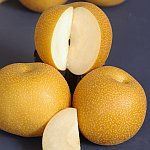|
|
|
Asian Pear Fruit Facts and Information
|
Availability by variety
|
 The term Asian pear describes a large group of pear varieties having crisp,
juicy fruit. When mature, the fruit are good to eat when harvested or for
several months after picking if held in cold storage. The crisp texture of an
Asian pear remains unchanged after picking or storage, unlike the flesh of
European pears such as Bartlett or Comice. There are three types of Asian pear:
round or flat fruit with green to yellow skin; round or flat fruit with
bronze-colored skin and a light bronze-russet; and pear-shaped fruit with green
or russet skin.
The term Asian pear describes a large group of pear varieties having crisp,
juicy fruit. When mature, the fruit are good to eat when harvested or for
several months after picking if held in cold storage. The crisp texture of an
Asian pear remains unchanged after picking or storage, unlike the flesh of
European pears such as Bartlett or Comice. There are three types of Asian pear:
round or flat fruit with green to yellow skin; round or flat fruit with
bronze-colored skin and a light bronze-russet; and pear-shaped fruit with green
or russet skin.
Pear, common name for about 20 species of trees of a genus in the rose family,
and for their fruit. The common pear is native to Europe; the Chinese sand pear
is native to the Orient. Both species are extensively cultivated for their fruit
in cool, humid, temperate regions throughout the world.
Under cultivation, standard pear trees attain heights of up to 9 m (30 ft),
with trunks 30 cm (12 in) or more in diameter. The leaves are oval and simple
and, unlike those of the apple, smooth and glossy. The white flowers, which are
borne in umbels, have five sepals, five petals, many stamens, and a single pistil.
The fruit is a pome, juicier than the apple, and varying from apple-shaped to
teardrop-shaped. Among different varieties, the thin skin varies in color from
light yellow and green through red and brown. The thick flesh varies in flavor
among different varieties. In young, unripe common pears, and in young and
mature Chinese sand pears, the flesh contains numerous gritty cells called stone
cells.
Pears are gathered from the trees before they are completely ripe and are
allowed to ripen in storage. Cold retards ripening, and heat speeds it. Pears
are eaten fresh and canned.
Commercial pear production in the United States averages about 700,000 metric
tons annually. The best North American pear-growing districts are in
California, Washington, and Oregon and, to a lesser degree, in the
northern United States from New England to the Great Lakes and in lower Canada.
Pears are grown extensively in home orchards in the United States.
Most pear varieties may be grown in either standard or dwarf sizes. Dwarf pears
are propagated by grafting a pear scion on a quince stock. Angoul?e, Elizabeth,
Louis Bonne, and Deal pears are desirable dessert varieties usually cultivated
as dwarfs. Anjou, Boussoc, and Tyson pears are about equally good in either
standard or dwarf sizes. Bosc, Washington, and Dix pears are usually grown as
dwarfs by a type of grafting called double working, in which stocks are grafted
onto stocks that have previously been dwarfed by grafting on quince. Bartlett,
Seckel, and Doyenn?pears are usually grown in standard sizes.
Basic Nutritional Facts: Pears contain about 16 percent carbohydrate and
negligible amounts of fat and protein. They are good sources of the B-complex
vitamins and also contain vitamin C; in addition, they contain small amounts of
phosphorus and iodine.
Detailed nutritional informatin can be found by searching the
USDA Nutritional Database
. Enter "Asian Pear" (no quotes) as the keyword and select the link and report
of interest.
Scientific classification:
Pears belong to the family Rosaceae. The common pear is classified as Pyrus
communis and the Chinese sand pear as Pyrus pyrifolia.
|
|